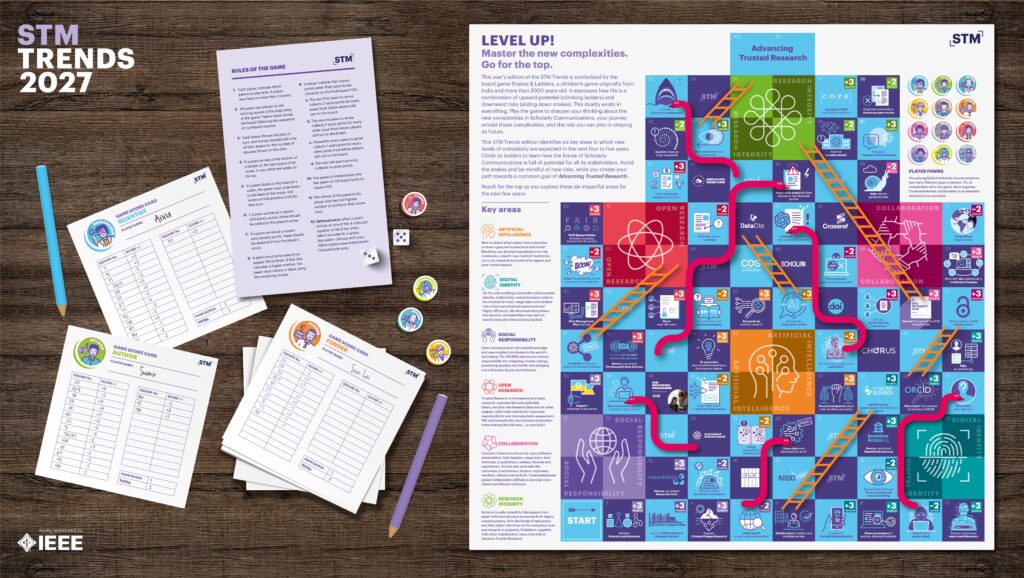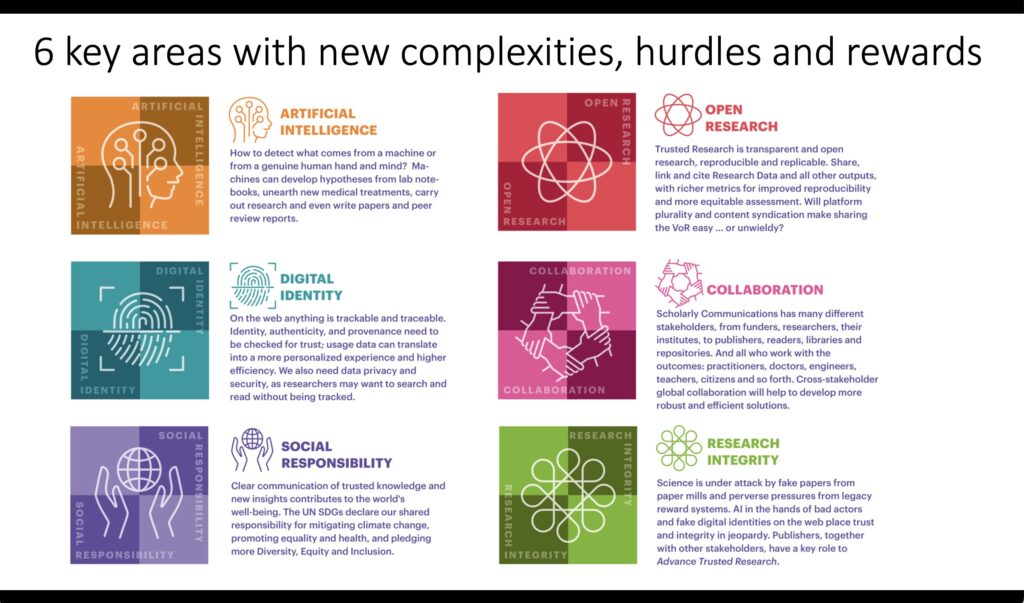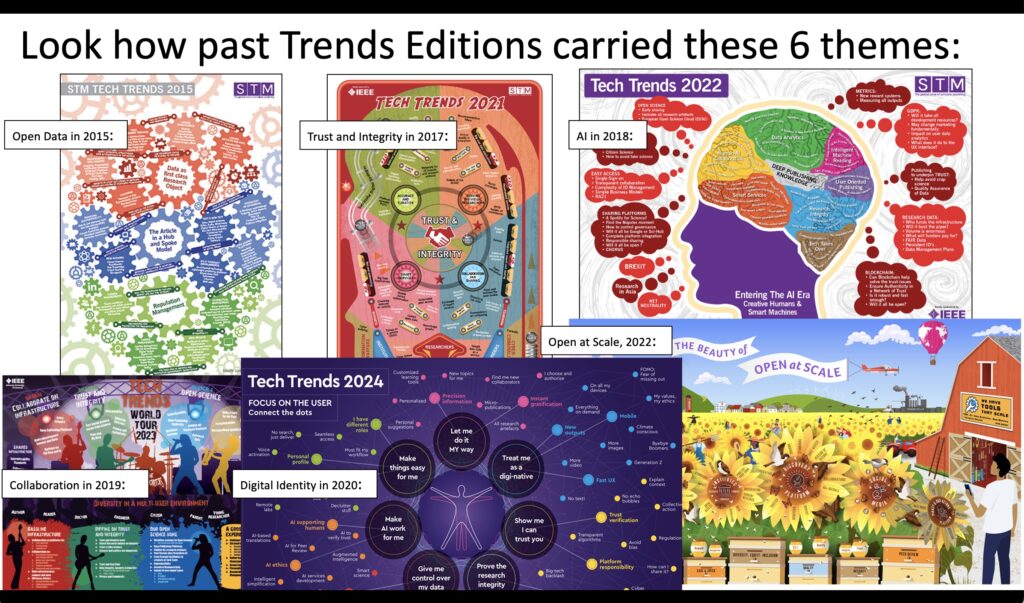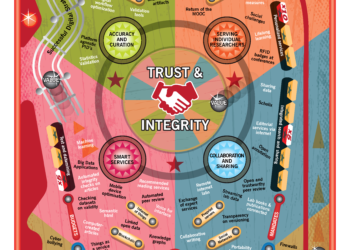The publishing process has always relied on technology, from the paper or ink upon which scribes noted their work (yes, pen, paper and ink are all technologies), to the earliest typesetters and printers, to the digital markup and repository tools of today. As technology continues its rapid advances and its impacts are widely felt, the need for technological awareness has grown. Increasingly, managing technology risk and change is as important to a publisher’s success as good editorial judgement and attentiveness to finances. Which is why the release of the annual STM Association Trends is a useful tool for people to grasp the direction and potential impact of technology changes in our community. The final output of this year’s efforts, STM Trends 2027, was released during the spring meeting of the STM Association in Washington, DC on Thursday.

Each year, a group of technology and thought leaders in scholarly publishing gather in London to brainstorm and discuss emerging technologies and their potential future impact on scholarly communications. After enforced digital exile because of the pandemic, members of the STM Future Lab and STEC Committees were able to reconvene at the Springer Nature Offices last December. I’ve participated in this group for many years now and I’ve found it both an extremely valuable discussion, but also a useful synthesizing exercise on the various threads impacting our industry. Using the Delphi Method of brainstorming and gathering ideas, the group is able to elicit a broad range of ideas of potentially impactful technology applications in our community. In this process, experts come together bringing their visions to the table and through discussion there is convergence of ideas that will likely have the largest impact. The group then engages in several rounds of discussion that highlight particular aspects of those technologies and how those changes are specifically applied in our ecosystem. These ideas are compiled and the resulting summary is then transformed into a graphic representation.
This year, the infographic output is focused on the theme “Level Up” based on the concept of the game Chutes and Ladders in the US, or Snakes and Ladders around the world. The STM Trends 2027 output builds upon this idea of a game focused on six key areas where publishers face both challenges and potential rewards. These areas center around Artificial Intelligence, Open Research, Digital Identity, Collaboration, Social Responsibility and Research Integrity. Around each of six items central to the advancement of scholarly communication, related activities can provide players the opportunity to be rewarded or penalized in their pursuit of advancing trusted research.

Artificial intelligence provides significant opportunity to develop hypotheses or discern patterns from massive sets of data or text corpuses. It can even provide tools to speed processing of research, or support translating ideas into text. However these same tools provide challenges for detecting original work by an author from automatically generated text.
As it relates to trends around digital identity, it will be important to both check the authenticity of people accessing content or services, as well as confirming identity of authors. The validity of the person engaging in scholarly activities can be important to verify. Publishers certainly don’t want to publish a paper from an author that doesn’t exist or wasn’t involved in the project. In this context, both data privacy and reader anonymity are also important. Organizations could get hacked or users can be subject to digital surveillance.
Social responsibility is becoming imbued in much of what is created and communicated, supporting an ecosystem that values the well-being of all involved and impacted by the scientific process. This includes engagement from under-represented groups, inclusivity, and recognition of worldwide problems as outlined in the UN’s Sustainable Development Goals. It also has practical implications in how publishers engage in their work, say through diversity on editorial boards and support for early career workers.
Open research & open science are critical to the outputs of science being reproduceable and replicable. Important are the elements of sharing, plurality, how it will be sustainable. Building upon the FAIR principles, ideally outputs will be more easily verifiable, reusable and therefore build trust. Yet, in this environment there’s the potential for confusion among the versions of records. And the variety of connected elements of an ‘exploded article’ could become unmanageable.
Collaboration is critical in many of these settings as the process of scientific communications involves many stakeholders and the process needs to reflect how it supports each in seeking to achieve those goals amongst many stakeholders. Infrastructure efforts are rarely undertaken or successfully implemented without a range of partners. There are many efforts and organizations that support collaboration in our community, NISO, Crossref, SNSI, and the Article Sharing Framework.
Each of these trends work in tandem to support research integrity – that element that drives the trustworthiness of science. Stakeholders all have an interest in avoiding the pitfalls of fake papers, paper mills and manipulated outputs. Publishers work to be transparent about retractions and with peer review. Participation in advancing work on ethics through organizations such as COPE can also support advancing research integrity. In this way we can all remain the custodians of trusted research.
The output exist as more than simply a viewable graphic. In keeping with the game framework, one can even download the board, along with the pawn stickers, a set of rules, notebook samples for score keeping. The STM website has a whole toolkit for the Board game available.
Looking how the past editions of the Tech Trends have carried these themes in different ways is another useful and interesting exercise. Open Data was an important feature of the 2015 Tech Trends, but we’re now seeing its broader adoption, sharing and reuse, particularly in the training of artificial intelligence systems. Back in 2018, the committee had already turned its attention to artificial intelligence and its growing power and application. Today, we’re seeing advances in large language models being able to turn out human-sounding output at scale, such that some authors are even using it to co-write papers. Trust and Integrity was the central focus in the 2017 report, which has exploded into the scholarly communications headlines in the past year with the issues of paper mills, faked results and AI-generated content driving industry headlines. Collaboration was recognized in 2019 as a core element of the many initiatives that spread across our ecosystem and the need to address them both locally and internationally across domains. And last year, the focus being on Openness at Scale and the problems and opportunities that presents.

With this year’s focus being on the combination of these trends and their real-world application at scale. No longer are discussions focused on whether researchers will share their data, but how will it be applied. Artificial intelligence has burst into the mainstream and now everyone is having to consider its appropriate use, and its future implications for recognition, testing, and verifying content. Because of the pandemic and other cultural trends, ever greater skepticism is being directed at scholarly outputs, to which failings in the review process add to the questioning of results. Combined, these trends lay out a landscape where “players in this game” can leverage these technologies to succeed. Open systems and open data sharing, can yield better results, more widely disseminated and applied outputs, leading to faster scientific advances. However, there are simultaneously risks caused by the technologies as well. The same set of tools can be applied to frustrate the best review and vetting systems, which can lead to significant reputational damage.
“The machine does not isolate man from the great problems of nature but plunges him more deeply into them.” – Antoine de Saint-Exupéry
The game of Snakes and Ladders historically has association not only with success and victory, but also humility and karma. It has at various times been interpreted and used as a tool for teaching the effects of good deeds versus bad, which is also an apt metaphor for technology in our times. It is possible to use the tools and methods of scholarly communications today, such as AI, preprint repositories, and open access publishing, to accelerate knowledge dissemination and speed discovery. Those same tools can be used for less noble purposes, such as paper-mill generation, scamming authors of APC payments, or faking results to advance one’s career. This situation reminds me of a quote by Antoine de Saint-Exupéry, “The machine does not isolate man from the great problems of nature but plunges him more deeply into them.” Technology and technical solutions are only an aspect of achieving an outcome. One must be mindful of the goals to which those technologies are applied. If those applying those technologies are setting them toward base ends, the outcomes may be despicable. On the other hand, if the same technologies are set to achieving laudable goals, the results could be valuable, even transformative. Ideally, everyone will focus on the shared goals of research integrity. Unlike a competitive game, the STM Trends 2027 is designed be played in such a way that everyone can Level Up!


